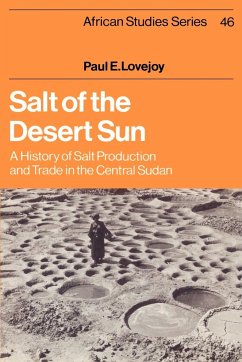A study of the organisation of the salt industry of the Sokoto Caliphate and Borno.
In this study of salt production and trade, Professor Lovejoy examines the interaction between ecology, technology and social structure as a means of analysing the organisation of the salt industry of the Sokoto Caliphate and Borno. By concentrating on the late nineteenth and early twentieth centuries, Lovejoy is able to establish a base-line from which to interpret earlier changes in the salt trade and thereby assess the impact of politics and economy on the history of the trade. By the end of the nineteenth century, production depended upon a combination of slavery, free migrant peasants, and workers from the haddad artisan caste. A complex marketing network serviced the various salines, although this network was intimately connected with the distribution of other commodities, especially textiles, grain and livestock. An examination of this marketing system reveals patterns of immigration and social advancement that are important in understanding the social history of the central Sudan.
Table of content:
List of tables; List of maps, figures and illustrations; Preface; 1. Salt in the history of the central Sudan; 2. Consumption of the central Sudan salts; 3. The chemistry and geology of the central Sudan salts; 4. The technology of production; 5. The volume of salt production; 6. The mobilisation of labour; 7. Proprietorship: the rights to salt and natron; 8. Salt marketing networks; 9. The trade and politics of salt; 10. The social organisation of trade and production; 11. Conclusion; Notes; Glossary; Bibliography; Index.
Hinweis: Dieser Artikel kann nur an eine deutsche Lieferadresse ausgeliefert werden.
In this study of salt production and trade, Professor Lovejoy examines the interaction between ecology, technology and social structure as a means of analysing the organisation of the salt industry of the Sokoto Caliphate and Borno. By concentrating on the late nineteenth and early twentieth centuries, Lovejoy is able to establish a base-line from which to interpret earlier changes in the salt trade and thereby assess the impact of politics and economy on the history of the trade. By the end of the nineteenth century, production depended upon a combination of slavery, free migrant peasants, and workers from the haddad artisan caste. A complex marketing network serviced the various salines, although this network was intimately connected with the distribution of other commodities, especially textiles, grain and livestock. An examination of this marketing system reveals patterns of immigration and social advancement that are important in understanding the social history of the central Sudan.
Table of content:
List of tables; List of maps, figures and illustrations; Preface; 1. Salt in the history of the central Sudan; 2. Consumption of the central Sudan salts; 3. The chemistry and geology of the central Sudan salts; 4. The technology of production; 5. The volume of salt production; 6. The mobilisation of labour; 7. Proprietorship: the rights to salt and natron; 8. Salt marketing networks; 9. The trade and politics of salt; 10. The social organisation of trade and production; 11. Conclusion; Notes; Glossary; Bibliography; Index.
Hinweis: Dieser Artikel kann nur an eine deutsche Lieferadresse ausgeliefert werden.








